Landfills: A Major Contributor to Climate Change We Can't Ignore
Written on
Understanding the Problem
It’s quite a sight, isn’t it? Image by Antoine GIRET on Unsplash.
Canada often boasts about its commitment to tackling climate change. Our leaders frequently discuss initiatives aimed at reducing pollution and fostering a sustainable future. However, this dialogue can sometimes feel like the ramblings of an intoxicated patron at a bar—full of grand ideas but lacking the necessary follow-through.
The fossil fuel industry has ample resources to influence these discussions, yet our leaders assure us that they will shift priorities, but only after a few more pipelines are constructed. Each year, the Canadian government publishes a national report detailing our greenhouse gas emissions and our efforts to lessen our impact.
Regularly reporting to the United Nations seems to keep our government somewhat accountable. It resembles keeping a fitness log: every minor achievement deserves acknowledgment.
As an enthusiast of video essays and documentaries, I often engage in research deep dives—yes, I’m that person at gatherings. During one of these explorations into greenhouse gas emissions, I uncovered a striking statistic: in the 2020 report, Canada indicated that approximately 23% of its methane emissions originated from landfills.

The Methane Dilemma
While Canada is not a leading methane producer—countries like China, India, and the United States dominate the list—it’s concerning that we have such a significant source of emissions that is largely overlooked. That 23% figure is considerable. Methane is significantly more potent than CO2 in the short term, being up to 80 times more effective at trapping heat.
Our agricultural practices need substantial reform. The livestock industry, for instance, faces severe challenges when markets fluctuate. During the COVID-19 pandemic, the sight of millions of culled animals being disposed of was a stark reminder of the issues at hand.
Yet, convincing people to reduce their meat consumption or to minimize food waste at home is an uphill battle. The statistics on household food waste are staggering. When we discard spoiled food and other waste, it all ends up in landfills.
You might wonder why this matters—after all, food waste is mostly biodegradable. However, the issue begins with transportation. Garbage trucks, which are still largely powered by fossil fuels, must transport waste long distances to landfills, consuming an excessive amount of fuel. On average, these trucks only achieve around 3 miles per gallon.
The longer they idle, the more emissions they generate. The waste collected is often taken to sorting facilities where recyclable materials are isolated. The remaining refuse is then transported to landfills, which are essentially mountains of trash that will eventually become archaeological sites.
I have immense respect for garbage collectors who work tirelessly to keep our communities clean. The problem lies within the system, not the dedicated individuals working in it.

The Landfill Lifecycle
Once the waste reaches the landfill, the decomposition process generates significant heat and gas. Composting at home is far more environmentally friendly than tossing food waste into the trash. In compost heaps, oxygen-rich conditions support aerobic bacteria, which produce CO2 that plants can utilize.
In contrast, landfills promote anaerobic decomposition, leading to methane production—a far worse scenario. The rotting organic matter gets buried under layers of plastic and other materials, creating ideal conditions for harmful bacteria to thrive.
As landfills contribute approximately 23% of Canada’s methane emissions, the numbers are alarming. In 2021, Canada generated around 1,401 kilotonnes of methane from landfills alone. The sheer volume of waste in landfills correlates with the population size.
The U.S., for example, with its population of approximately 334 million, produces an immense amount of methane, equivalent to the emissions from millions of gasoline-powered vehicles.
The video title is "This Concrete Dome Holds A Leaking Toxic Timebomb | Foreign Correspondent - YouTube," highlighting the dangers posed by waste management systems.
Solutions and Collective Action
There is no single solution to this predicament. While I’m not a city planner or environmental engineer, I can suggest actionable steps. Reducing single-use plastic consumption, composting kitchen scraps, and advocating for municipal composting initiatives are all viable strategies.
Collective action is crucial; we need to pressure corporations to change their products rather than solely relying on individuals to make an impact. The concept of an individual carbon footprint often overshadows the larger systemic issues we face.
Ultimately, awareness is the first step toward change. By educating ourselves and uniting for a common cause, we can push for meaningful reform. Solidarity is our most powerful tool in this fight.
Thank you for reading. If you want to explore more insightful content, consider joining Medium’s membership for $5 a month, granting you access to a wealth of articles. Your support helps sustain my work and allows us to continue the conversation on pressing issues like human rights and environmental justice.